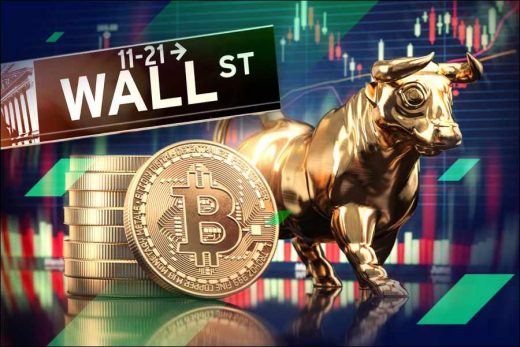Wall Street risk appetitstays strong. To Wall Street’s old guard, it had seemed inevitable. Once bonds started offering decent payouts again, people would lose the taste for risk that flourished when rates were zero.
That’s not quite how it’s playing out. While Treasuries have done their part, with two-year notes offering around 5% for much of April, the predicted retreat from speculation has yet to materialize. Take the last five days, when Bitcoin rose 9%, stocks and commodities surged and a few social-media posts sent GameStop and AMC Entertainment higher in a reprisal of 2021’s meme frenzy.
Healthy as risk-free rates are, they’ve done little to curb appetites for fancier forms of yield elsewhere, from options-selling exchange-traded funds to structured products. ETFs that use derivatives to jack up cash payouts have attracted $13 billion of fresh money in the year’s first four months, according to data compiled by Global X ETFs.
All of it sits awkwardly with theories that caught on in the pre-pandemic era of zero interest-rate policy, or ZIRP, which held that fervor for speculative assets and complex investment products was a direct result of investors finding no alternatives in safer markets.
“There is still a huge amount of money circulating in markets, whether that is caused by fiscal stimulus or whether that has been caused by rates being very low for a very long period,” said Edward Park, chief asset management officer at Evelyn Partners, a wealth manager in London. “GameStop et cetera is probably a symptom of that rather than anything else.”
The resilience of gambler spirits continues to confound the conventional wisdom. Just this week, Gary Cohn, chief economic adviser to former President Donald Trump, posited that an extended period of high rates is preventing investors from taking risks.
But rather than excessive pessimism, the main threat right now is that everyone from hedge funds on down is so bulled up that the market risks collapsing under the weight of its own exuberance, a note from Morgan Stanley’s trading desk said on Thursday. Increased concentration in the same stocks, along with elevated investor positioning, means that if anything goes wrong, the consequences will be swift.
“These dynamics increase fragility in the market,” the team including Christopher Metli and Amanda Levenberg wrote. “The risks are intertwined – high overlap between hedge fund longs and the S&P 500 suggest that any hedge fund derisking may drag the broader market lower, while on the other side any macro shock is more likely to drag hedge fund portfolios with it.”
From stocks to bonds to commodities, all major assets advanced this week for the best pan-market rally of 2024 as data on softer retail sales and cooling inflation bolstered optimism that the Fed will soon reverse its tightening policy. The S&P 500 climbed for a fourth straight week, the longest since February, while the Dow Jones Industrial Average topped 40,000 for the first time.
In a sign retail involvement in the market is increasing, off-exchange venues, often platforms where computerized traders pair off order flow from brokerages, saw transactions spike to a record 52% of the market’s total.
“Retail traders unite again in 2024,” Scott Rubner, a managing director at Goldman Sachs Group Inc., wrote in a note Friday. “This is something that I now have to monitor daily again,” he added. “I will be checking the message boards this weekend as HODL investors look for new gamification names next week.”
While debate rages over how depleted American savings have become, among the mostly affluent investor class, purse strings remain loose. Almost $12 billion was poured into stock funds in the week through Wednesday, while those focusing on high-yield bonds attracted money for two straight weeks, EPFR Global data compiled by Bank of America Corp. shows.
In the eyes of bulls, financial conditions have yet to bite — a legacy of years of quantitative easing. It helps, of course, that the US economy has remained steady, supporting the case for risk taking.
A related theory in explaining the durability of risk appetites holds that the so-called “Fed put” has been a fact of life in markets for so long that people remain conditioned to act as if the central bank stands ready in its role as market savior.
“As long as the optionality of a cut remains, we would argue that the Fed put is on the table, which should continue to support risky assets,” Jefferies Financial Group Inc. strategists led by Mohit Kumar wrote in a Friday note.
In a BofA survey released this week, fund managers revealed the highest stock allocation since January 2022, right before the Fed started hiking rates. Eight out of 10 expected rate cuts in the second half — and no recession.
Even in the world of income products, demand has ballooned in riskier sections despite T-bills — practically cash, when it comes to the risk profile — offering more than 5%.
Lured by yields that in some cases are touted to exceed 100% annually, investors are flocking to options-selling ETFs. After more than 20 new launches this year, total assets by overwriting ETFs have jumped to a record $81 billion, Global X data shows. Cboe Global Markets Inc. recently started a margin relief program to make it easier for traders to write option contracts on indexes.
These products have boomed despite the risk that the dividends can be eaten up by losses associated with the very options that traders were selling to goose up returns.
“Many investors have gravitated towards these strategies because of their attractive yields and lower volatility profiles,” said Adam Phillips, a portfolio manager at EP Wealth Advisors. “Of course, this income and stability comes at a price and we’ve seen how these strategies can fall well short of broader market benchmarks.”
Meanwhile, US structured-product sales rose 20% to a record $132 billion in 2023 and have already reached $61 billion in 2024, according to Structured Products Intelligence. Many of these complex notes — famously an Asian favorite in the low-rate years — pay investors a coupon by effectively selling volatility on stocks and can lose money when the underlying securities plunge below a threshold.
Offerings like these have gained favor as financial advisers look for alternatives to bonds after witnessing their selloff in recent years, says Cullen Roche, chief investment officer at Discipline Funds.
More than two years after the Fed kicked off its tightening campaign, the question now is whether all this will change as investors adapt to a high-rate world.
Views: 297





